
(a)
Interpretation:
The product expected when
Concept introduction:
The nucleophilic substitution reactions are the reactions in which a group is substituted by an nucleophile. The
The
Answer to Problem 10.39AP
The product obtained on the reaction of

Explanation of Solution
The product obtained on the reaction of

Figure 1
The alcohol
The product obtained on the reaction of
(b)
Interpretation:
The product expected when
Concept introduction:
An
Answer to Problem 10.39AP
The product obtained on the reaction of

Explanation of Solution
The product obtained on the reaction of

Figure 2
The alcohol
The product obtained on the reaction of
(c)
Interpretation:
The product expected when
is to be stated.
Concept introduction:
Primary and secondary alcohols can be oxidized into
Answer to Problem 10.39AP
The products obtained on the reaction of

Explanation of Solution
The products obtained on the reaction of

Figure 3
Primary alcohols on oxidation give aldehyde. Aldehydes can further undergo oxidation to give
The products obtained on the reaction of
(d)
Interpretation:
The product expected when
Concept introduction:
Acid-base reaction are among the fastest reaction in the chemistry. Acids and bases react vigorously generating heat and water normally. Metals are basic in nature due to the presence of free electrons to donate. Alcohols are both acidic and basic in nature.
Answer to Problem 10.39AP
The product obtained on the reaction of

Explanation of Solution
The product obtained on the reaction of

Figure 4
The sodium hydride is a very strong base and it undergoes acid-base reaction with alcohol
The product obtained on the reaction of
(e)
Interpretation:
The product expected when the product of part (d) is reacted with
Concept introduction:
The nucleophilic substitution reactions are the reactions in which a group is substituted by an nucleophile. The rate of reaction depends upon the nucleophilicity and concentration of the nucleophile.
The
Answer to Problem 10.39AP
The product obtained on the reaction of sodium

Explanation of Solution
The product of part (d) is sodium
The product obtained on the reaction of sodium

Figure 5
The sodium
The product obtained on the reaction of sodium
(f)
Interpretation:
The product expected when
Concept introduction:
The hydroxide group in alcohols is not a good leaving group in order to perform a nucleophilic substitution reaction on alcohols to produce more compounds. Hydroxide group is made a good leaving group with the help of some compounds like methanesulfonyl chloride and p-toluenesulfonyl chloride.
Answer to Problem 10.39AP
The product obtained on the reaction of
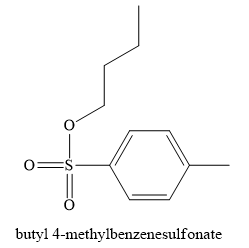
Explanation of Solution
The product obtained on the reaction of
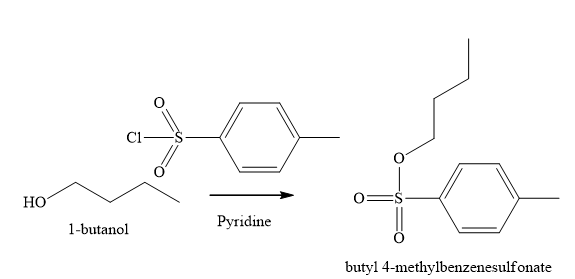
Figure 6
The reaction of an alcohol with sulfonate derivatives such as methanesulfonyl chloride and
The product obtained on the reaction of
(g)
Interpretation:
The product expected when
Concept introduction:
The reaction of an
Answer to Problem 10.39AP
The product obtained on the reaction of

Explanation of Solution
The product obtained on the reaction of

Figure 7
The
The product obtained on the reaction of
(h)
Interpretation:
The product expected when
Concept introduction:
The nucleophilic substitution reactions are the reactions in which a group is substituted by an nucleophile. The rate of reaction depends upon the nucleophilicity and concentration of the nucleophile.
The
Answer to Problem 10.39AP
The product obtained on the reaction of

Explanation of Solution
The product obtained on the reaction of

Figure 8
The alcohol
The product obtained on the reaction of
(i)
Interpretation:
The product expected when
Concept introduction:
The nucleophilic substitution reactions are the reactions in which a group is substituted by an nucleophile. The rate of reaction depends upon the nucleophilicity and concentration of the nucleophile.
The
Answer to Problem 10.39AP
The product obtained on the reaction of

Explanation of Solution
The product obtained on the reaction of

Figure 9
The alcohol
The product obtained on the reaction of
(j)
Interpretation:
The product expected when product of part (a) is reacted with
Concept introduction:
The reaction of an alkyl halide with a metal like magnesium in the presence of dry ether leads to the formation of
Answer to Problem 10.39AP
The product obtained on reaction of
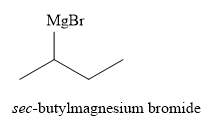
Explanation of Solution
The product of part (a) is
The product obtained on reaction of

Figure 10
The alkyl halide reacts with magnesium metal in dry ether to produce the Grignard reagent. The
The product obtained on reaction of
(k)
Interpretation:
The product expected when the product of part (f) is reacted with
Concept introduction:
An
Answer to Problem 10.39AP
The product obtained on the reaction of

Explanation of Solution
The product of part (f) is
The product obtained on the reaction of
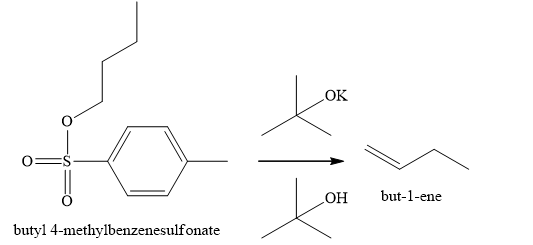
Figure 11
The ester
The product obtained on the reaction of
(l)
Interpretation:
The product expected when
Concept introduction:
The hydroxide group in alcohols is not a good leaving group. In order to perform a nucleophilic substitution reaction on alcohols to produce more compounds hydroxide group is made a good leaving group with the help of some compounds like methanesulfonyl chloride and
Answer to Problem 10.39AP
The product obtained when
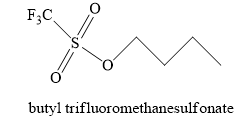
Explanation of Solution
The product obtained when

Figure 12
The triflic anhydride is also one of the compounds used to make hydroxide group a good leaving group. This compound is used much more reactive ester as compared to given by tosylates and mesylates. The yield of the product obtained by this ester of substitution is very high.
The
The product obtained when
(m)
Interpretation:
The product expected when the product of (l) is reacted with anhydrous
Concept introduction:
The hydroxide group in alcohols is not a good leaving group in order to perform a nucleophilic substitution reaction on alcohols to produce more compounds. Hydroxide group is made a good leaving group with the help of some compounds like methanesulfonyl chloride and
Answer to Problem 10.39AP
The product obtained when butyl trifluoromethanesulfonate is reacted with anhydrous

Explanation of Solution
The product obtained when butyl trifluoromethanesulfonate is reacted with anhydrous

Figure 13
The compound butyl trifluoromethanesulfonate undergoes nucleophilic substitution reaction with
The product obtained when butyl trifluoromethanesulfonate is reacted with anhydrous
Want to see more full solutions like this?
Chapter 10 Solutions
Organic Chemistry
- Draw the Haworth projection of the disaccharide made by joining D-glucose and D-mannose with a ẞ(1-4) glycosidic bond. If the disaccharide has more than one anomer, you can draw any of them. Click and drag to start drawing a structure. Xarrow_forwardEpoxides can be opened in aqueous acid or aqueous base to produce diols (molecules with two OH groups). In this question, you'll explore the mechanism of epoxide opening in aqueous acid. 2nd attempt Be sure to show all four bonds at stereocenters using hash and wedge lines. 0 0 Draw curved arrows to show how the epoxide reacts with hydronium ion. 100 +1: 1st attempt Feedback Be sure to show all four bonds at stereocenters using hash and wedge lines. See Periodic Table See Hint H A 5 F F Hr See Periodic Table See Hintarrow_forward03 Question (1 point) For the reaction below, draw both of the major organic products. Be sure to consider stereochemistry. > 1. CH₂CH₂MgBr 2. H₂O 3rd attempt Draw all four bonds at chiral centers. Draw all stereoisomers formed. Draw the structures here. e 130 AN H See Periodic Table See Hint P C Brarrow_forward
- You may wish to address the following issues in your response if they are pertinent to the reaction(s) you propose to employ:1) Chemoselectivity (why this functional group and not another?) 2) Regioselectivity (why here and not there?) 3) Stereoselectivity (why this stereoisomer?) 4) Changes in oxidation state. Please make it in detail and draw it out too in what step what happens. Thank you for helping me!arrow_forward1) Chemoselectivity (why this functional group and not another?) 2) Regioselectivity (why here and not there?) 3) Stereoselectivity (why this stereoisomer?) 4) Changes in oxidation state. Everything in detail and draw out and write it.arrow_forwardCalculating the pH at equivalence of a titration 3/5 Izabella A chemist titrates 120.0 mL of a 0.7191M dimethylamine ((CH3)2NH) solution with 0.5501 M HBr solution at 25 °C. Calculate the pH at equivalence. The pk of dimethylamine is 3.27. Round your answer to 2 decimal places. Note for advanced students: you may assume the total volume of the solution equals the initial volume plus the volume of HBr solution added. pH = ☐ ✓ 18 Ar Boarrow_forward
- Alcohols can be synthesized using an acid-catalyzed hydration of an alkene. An alkene is combined with aqueous acid (e.. sulfuric acid in water). The reaction mechanism typically involves a carbocation intermediate. > 3rd attempt 3343 10 8 Draw arrows to show the reaction between the alkene and hydronium ion. that 2nd attempt Feedback 1st attempt تعمال Ju See Periodic Table See Hint F D Ju See Periodic Table See Hintarrow_forwardDraw the simplified curved arrow mechanism for the reaction of acetone and CHgLi to give the major product. 4th attempt Π Draw the simplified curved arrow mechanism T 3rd attempt Feedback Ju See Periodic Table See Hint H -H H -I H F See Periodic Table See Hintarrow_forwardSelect the correct reagent to accomplish the first step of this reaction. Then draw a mechanism on the Grignard reagent using curved arrow notation to show how it is converted to the final product. 4th attempt Part 1 (0.5 point) Select the correct reagent to accomplish the first step of this reaction. Choose one: OA Mg in ethanol (EtOH) OB. 2 Li in THF O C. Li in THF D. Mg in THF O E Mg in H2O Part 2 (0.5 point) Br Part 1 Bri Mg CH B CH, 1 Draw intermediate here, but no arrows. © TE See Periodic Table See Hint See Hint ין Harrow_forward
- Select the product for the following reaction. HO HO PCC OH ○ OH O HO ○ HO HO HOarrow_forward5:45 Х Select the final product for the following reaction sequence. O O 1. Mg. ether 2.D.Oarrow_forwardBased on the chart Two similarities between the molecule with alpha glycosidic linkages. Two similarities between the molecules with beta glycosidtic linkages. Two differences between the alpha and beta glycosidic linkages.arrow_forward
 ChemistryChemistryISBN:9781305957404Author:Steven S. Zumdahl, Susan A. Zumdahl, Donald J. DeCostePublisher:Cengage Learning
ChemistryChemistryISBN:9781305957404Author:Steven S. Zumdahl, Susan A. Zumdahl, Donald J. DeCostePublisher:Cengage Learning ChemistryChemistryISBN:9781259911156Author:Raymond Chang Dr., Jason Overby ProfessorPublisher:McGraw-Hill Education
ChemistryChemistryISBN:9781259911156Author:Raymond Chang Dr., Jason Overby ProfessorPublisher:McGraw-Hill Education Principles of Instrumental AnalysisChemistryISBN:9781305577213Author:Douglas A. Skoog, F. James Holler, Stanley R. CrouchPublisher:Cengage Learning
Principles of Instrumental AnalysisChemistryISBN:9781305577213Author:Douglas A. Skoog, F. James Holler, Stanley R. CrouchPublisher:Cengage Learning Organic ChemistryChemistryISBN:9780078021558Author:Janice Gorzynski Smith Dr.Publisher:McGraw-Hill Education
Organic ChemistryChemistryISBN:9780078021558Author:Janice Gorzynski Smith Dr.Publisher:McGraw-Hill Education Chemistry: Principles and ReactionsChemistryISBN:9781305079373Author:William L. Masterton, Cecile N. HurleyPublisher:Cengage Learning
Chemistry: Principles and ReactionsChemistryISBN:9781305079373Author:William L. Masterton, Cecile N. HurleyPublisher:Cengage Learning Elementary Principles of Chemical Processes, Bind...ChemistryISBN:9781118431221Author:Richard M. Felder, Ronald W. Rousseau, Lisa G. BullardPublisher:WILEY
Elementary Principles of Chemical Processes, Bind...ChemistryISBN:9781118431221Author:Richard M. Felder, Ronald W. Rousseau, Lisa G. BullardPublisher:WILEY





